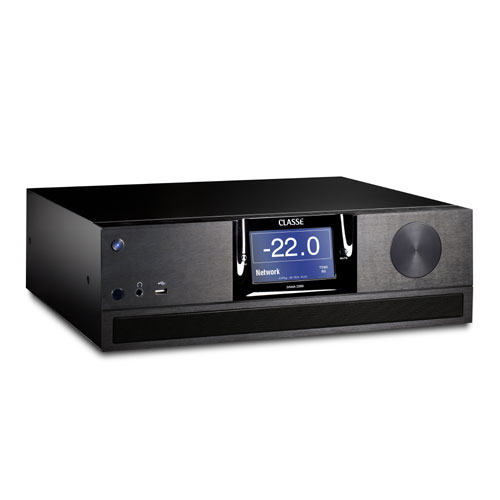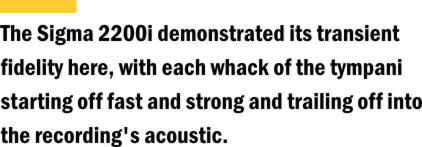Classé
Audio • Sigma 2200i Integrated Amplifier
". . . a dream machine for many all-digital audiophiles."
Around back, you will find a plethora of connection options. On the left top row are the speaker connectors -- beautiful five-way gold-plated binding posts that let you use spades, bare wire or banana plugs. The binding posts flank a round, silent-running exhaust fan. Below the binding posts is the IEC inlet. On the right side is where all the fun begins. The top row is for analog connections, featuring one balanced and one single-ended subwoofer output (derived directly from the onboard DAC), along with one pair of balanced and two pairs of single-ended inputs. Row two, just below, features four HDMI inputs and one HDMI output. Row three, on the bottom, starts with an Ethernet jack, a USB Type B jack, two TosLink inputs, two gold-plated S/PDIF inputs, and IR in/out jacks. If you plan to use this integrated for audio only, home theater, or a combination of both, the Sigma 2200i has you covered. The power output of the Sigma 2200i is 200Wpc at 8 ohms and double that at 4 ohms. Its switching amplifier section is identical to that of Classé's Sigma AMP2 and CA-D200 power amps, which addresses dead-band time and its attendant distortion, while using the least negative feedback possible. Classé's proprietary switch-mode power supply with power-factor correction ensures high power delivery -- up to 1000W -- and efficiency. D is still the backbone of my digital-music collection, so I used my Oppo BDP-105D as a transport to send CD-resolution data to a Genesis Digital Lens and then into the Sigma 2200i's S/PDIF input. Playing Mary Gauthier’s CD Between Daylight and Dark [Lost Highway B0008965-02], I heard the complete personality of this dark recording, by which I mean it's a tad bass heavy. However, that bass wasn’t just some indistinct mess bloating the bottom end of the music. No, it was clean, clear, deep and very present. Despite the prominence of the bass in the mix, I could still hear Gauthier’s fingers plucking and strumming her acoustic guitar as well as the sound of the guitar body. And her voice was reproduced as the supple instrument it is -- just as I’ve heard this disc reproduced so many times before. I just got a clearer sense of all the above, as there was less circuitry for the signal to pass through. Needless to say, the Sigma 2200i seemed to be passing the digital signal faithfully, the recording sounding distinct, fully itself. More of same with Marcus Miller’s M2 CD [Telarc CD-83534]. It was immediately apparent that Miller favors an electric bass over the acoustic one, which was used on the Gauthier CD. There was the electric purr reproduced more clearly, and perhaps more accurately, than I’d ever heard from my system. No, it didn’t go as deep as an upright acoustic bass, but then I didn’t expect it to. I really enjoyed hearing Miller use his bass as a lead instrument on favorite tracks like "Burning Down the House" and "Red Baron" (the Billy Cobham tune that makes this album a must-own). Finally, I grabbed one of the CDs I always listen to any new piece of gear with because it gives the best sense of presence and space and the most vivid soundstaging of any digital disc I own -- Andy McCloud’s Blues For Bighead [Mapleshade CD 07832]. The title cut begins with McCloud standing back behind the left speaker, going over the lead-in for the tune with drummer Victor Jones, who is sitting on a wooden riser behind the right speaker. First, McCloud sounds live; his finger snaps are flesh on flesh. Jones's response is also realistic, and when he taps his foot on that riser, I got the sense not only of it being wood, but there being a hollow space underneath. When McCloud sounds off the beginning, and alto saxophonist Joe Ford and vibe player Steve Nelson come in, they are clearly placed in front of McCloud and Jones, and yet each occupies his own space. The tune toddled right along, with no sense of excessive speed or lag, and each instrument was reproduced with a cleanliness and clarity that bespoke the real thing. Played back through the Sigma 2200i, this disc offered a sensation such as I’ve never quite heard before, causing me to believe that there was something to Classé's design decisions.
I then pulled out the Pure Audio Blu-ray release of Queen’s A Night at the Opera [Universal 00602537327713] and slipped it into the Oppo. Listening to the 24-bit/96kHz mix again through the HDMI input on the Sigma 2200i allowed me to hear deeper into the music than I ever have. I could more easily hear the background vocals as separate entities, and gauge their positions with slightly greater specificity. The instruments offered a greater sense of reality on this high-resolution Blu-ray, as I noticed listening to the piano that opens the song "You’re My Best Friend." It just sounded more like a real piano, with a greater sense of the percussive nature of the instrument. Thus far, all the digital music I had played through the Classé Sigma 2200i, whether via S/PDIF or HDMI, seemed to bring me closer to, and deeper into, the performances, thanks to the almost non-existent conversion processing. But it was time to move on to my favorite media -- SACDs and LPs. Given that both SACD and vinyl would have to be played through the analog inputs, which convert analog signals to digital, I wondered how the DSD recording process of SACDs would come across being converted to 24-bit/96kHz PCM. And as to vinyl, I was very interested in how the Sigma 2200i and its optional phono stage would make what I consider the highest-resolution medium sound. With SACD, the Sigma 2200i lost just a bit of the acoustic space that infuses any good SACD. Yes, I could, and did, still listen to my SACD collection, but I always felt that I was hearing less of the musical detail that I knew was on those discs. Moving to vinyl, well, let’s just say that the Sigma 2200i is not the device for those who love good analog replay. All the warmth, space, and realness that good analog does so well was lost via the 2200i and its optional phono stage. But keep in mind, the Sigma 2200i was designed for those whose feet are planted firmly in the digital world, not so much in the analog one, so the results here are not so surprising. However, despite these setbacks, the Sigma 2200i was not a one-trick pony. It has an extra surprise up its sleeve. Connecting via the Ethernet connection to a router makes the Sigma 2200i a network player via Apple Airplay and DLNA. I could use my iPhone to play both my iTunes and Tidal libraries wirelessly. And best of all, hitting the Airplay button on my phone automatically moved the Sigma 2200i from whatever input it was set on to Network. No muss, no fuss, just fast musical pleasure. As I mentioned, the Sigma 2200i comes with a 1/4" headphone jack, and I listened through it as well. I plugged in my AudioQuest NightHawk headphones and played the title tune from the Andy McCloud CD Blues For Bighead. The Sigma 2200i produced a very creditable performance, with emphasis on the leading-edge transients. When I used my usual headphone setup, with my cans plugged into an Original Electronics Master headphone amp, I heard more of everything. This was not surprising when you consider that the Master is strictly a headphone amp with a heavy-duty outboard power supply. But I could certainly listen to the music coming from the Sigma 2200i and enjoy what I heard. Finally, comparing the Sigma 2200i to my Audio Research LS17 SE preamp ($5500) and Parasound A23 power amp ($995) combo was illuminating. On the purely digital side, the Sigma had a clear edge, thanks to the total absence of any digital conversion -- with the above-noted caveats regarding SACD. The sound of the 2200i was just clearer and more open. But when I turned to analog, there was a drop in the clarity and vividness. The sound wasn't bad by any means; different probably sums it up best, and that's what was happening within the 2200i as well: analog and DSD via the Oppo's analog outputs were converted to PCM.
he Classé Sigma 2200i has abundant connectivity
for all of your digital needs, handles audio and video well, and the lack of A-to-D then
D-to-A conversion came as close to a "straight wire with gain" as I’ve
experienced in my system. As long as you’re not exclusive with analog as source
material, the Sigma 2200i can be the answer for all of your music needs. It will be a
dream machine for many all-digital audiophiles.
|
|||||||||||




 Moving on to
high-resolution discs, I pulled my copy Shakespeare’s The Tempest, Reference
Recordings' 24-bit/176.4kHz DVD-A [RR-115] as scored by Sibelius and Sullivan. What I
heard using the HDMI input was a deep, wide soundstage that presented each part of the
orchestra cleanly and clearly. The sound flowed smoothly with no choppiness, much as it
would have had I been listening at a live venue. The Sigma 2200i demonstrated its
transient fidelity here, with each whack of the tympani starting off fast and strong and
trailing off into the recording's acoustic.
Moving on to
high-resolution discs, I pulled my copy Shakespeare’s The Tempest, Reference
Recordings' 24-bit/176.4kHz DVD-A [RR-115] as scored by Sibelius and Sullivan. What I
heard using the HDMI input was a deep, wide soundstage that presented each part of the
orchestra cleanly and clearly. The sound flowed smoothly with no choppiness, much as it
would have had I been listening at a live venue. The Sigma 2200i demonstrated its
transient fidelity here, with each whack of the tympani starting off fast and strong and
trailing off into the recording's acoustic. Don’t get me wrong --
24-bit/96kHz PCM can sound very good -- but the added conversion didn't sound as
immediate. If you are a digital audiophile, especially one who loves streaming and network
replay of your music, or has a large collection of CDs, DVD-As, and Blu-ray audio (or
video) discs, or who wants to be able to combine audio and video replay into one
two-channel system, then the Sigma 2200i is going to be a real eye- and ear-opener. But if
you still rely on analog as your primary medium, your ears will have to tell you if all of
the digital proficiency of the the Sigma 2200i will satisfy.
Don’t get me wrong --
24-bit/96kHz PCM can sound very good -- but the added conversion didn't sound as
immediate. If you are a digital audiophile, especially one who loves streaming and network
replay of your music, or has a large collection of CDs, DVD-As, and Blu-ray audio (or
video) discs, or who wants to be able to combine audio and video replay into one
two-channel system, then the Sigma 2200i is going to be a real eye- and ear-opener. But if
you still rely on analog as your primary medium, your ears will have to tell you if all of
the digital proficiency of the the Sigma 2200i will satisfy.